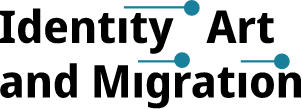1894-1951
“The origin of all art is what we call propaganda. … I do not say that art is my aim; art is my means.”
-Arthur Szyk, cited in Mary Bragiotti, “Szyk Makes the Axis Writhe,” New York Post Weekly Picture Magazine, June 3, 1944
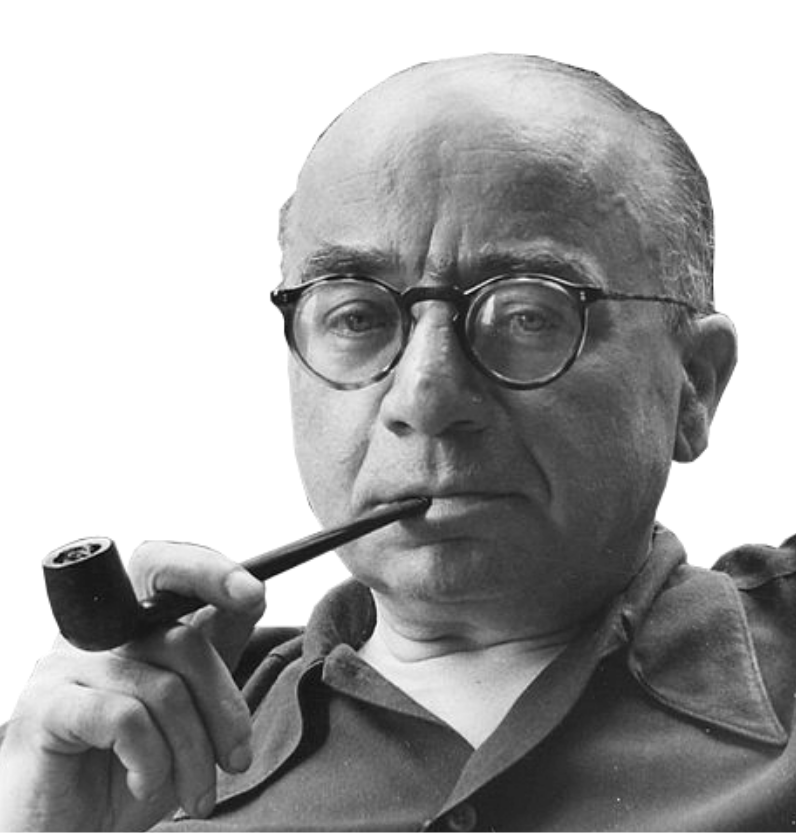
Contributing to the Allied War Effort from Canada and the US
Polish-born Szyk was an established artist dividing his time between Poland and France when he moved to England in 1937. His work as a shrewd political satirist was well known in the US. In 1940, it seems likely that the Polish and British governments aided Szyk’s departure from England to Canada and then the United States. Szyk and his immediate family disembarked in Halifax, Nova Scotia on July 12, 1940, along with some 2,000 children who had been evacuated from Great Britain to Canada.
In October 1940 he obtained a visitor visa to the United States, and decided to stay there, trading it in for an immigration visa.
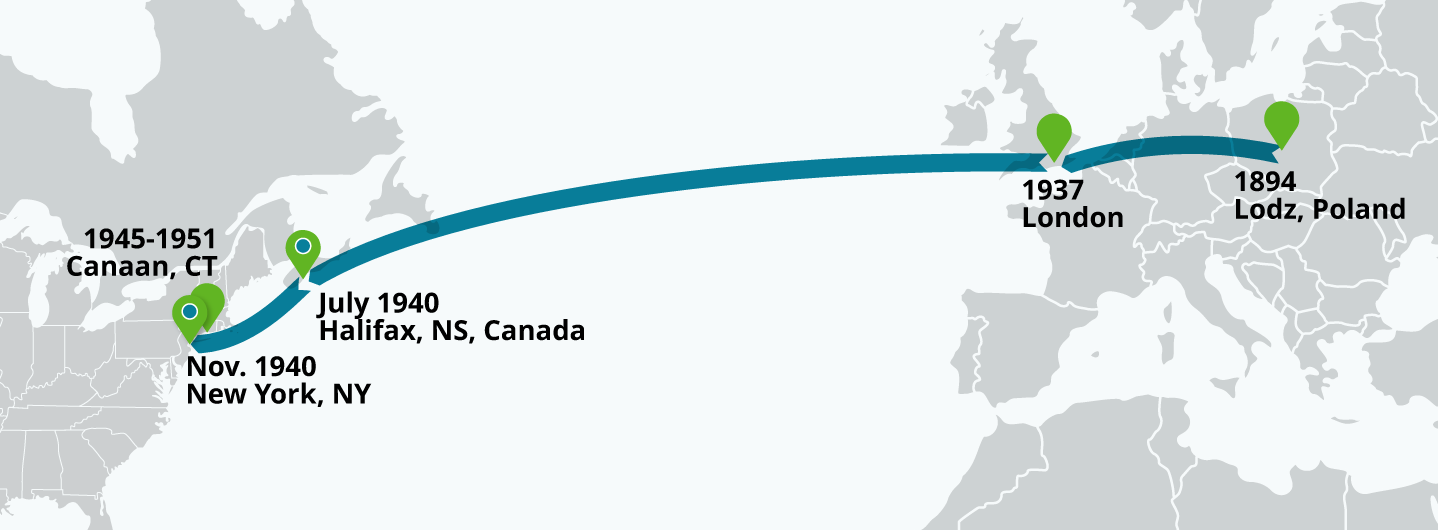
Key Facts
Szyk was well known for his ornate illuminations and book illustrations of historical subjects and Jewish themes.
Szyk was internationally known in the 1920s and 1930s.
Skilled with words as well as a brush, Szyk sometimes described himself as “FDR’s soldier in art.”
Following Germany’s invasion of Poland in 1939, he focused on producing anti-Nazi cartoons, first from England and then in 1940 from Canada and the United States.
Did you Know?
By summer 1940, Lisbon was the only neutral port in continental Europe with ships still sailing semi-regularly to the United States. Polish Jews were trapped in eastern Europe and no longer competing for American immigration slots.
Early Years
Arthur Szyk was born to Jewish parents, Solomon and Eugenia Szyk in Łódź, Poland, part of the Russian Empire at that time. He had his first public art exhibition at age 15, and had formal art training in Paris and Krakow. He visited Palestine in 1914 with a group of Polish-Jewish artists and studied Muslim art.
Then he was drafted into the Russian Army and served in World War I. Between 1919 and 1920 during Poland’s war against the Soviet Bolsheviks, Szyk served as a cavalry officer and artistic director of the Department of Propaganda for the Polish Army in Łódź. During that time, Szyk produced small paintings based on themes from Jewish history and Slavic folk tales.
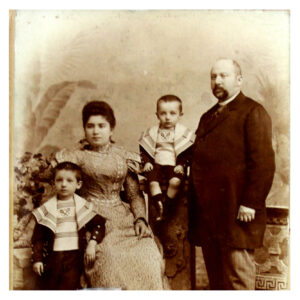
Arthur Szyk with Brother and Parents, n. d.
Satan Leads the Ball, New York 1942
Pen and brush, watercolour and Indian ink on paper. Dimensions unknown. Location unknown
Digital Image via Wikimedia Commons
International Recognition
In 1921, Szyk moved to Paris, with his wife Julia and their son George. By then, he was well known for his illuminations and book illustrations, in a style reminiscent of Persian miniatures. He worked on several significant projects in France, including illustrating the Statute of Kalisz, the Haggadah, and a series of watercolors on the American Revolutionary War. The themes of his most admired works, democracy and Judaism, earned him both fame and significant commissions.
Szyk resided in England from 1937-1940 to supervise the publication of the Haggadah, a Jewish religious text that is read every Passover to celebrate the Exodus from Egypt and the triumph of the Jewish people over its enemies.
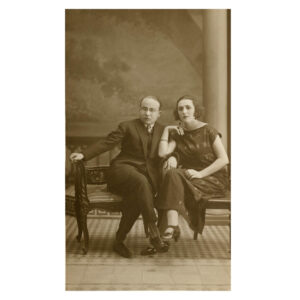
Arthur and Julia Szyk, Paris 1920s
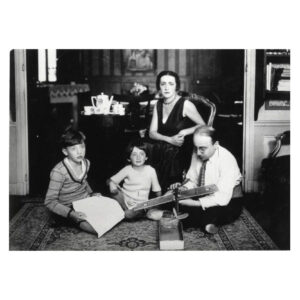
Arthur Szyk, wife Julia, and Children George and Alexandra (Paris), 1929
Arthur Szyk’s Artistic Crusade to the New World
Szyk and his family left England for Canada in 1940. Here, he created artwork that called public attention to the Nazi threat and paid tribute to the plucky British and Canadian servicemen who were fighting to defend democracy.
After spending some six months in Canada, Szyk departed for the United States. He worked at a feverish pace, and his anti-Axis images graced the covers and inside pages of leading magazines, like Time, Colliers, Esquire, Look, The American Mercury, Coronet, and Liberty. His cartoons appeared regularly in The New York Post, The Chicago Sun, and PM. Millions of Americans saw his work, even if they could not pronounce his name.
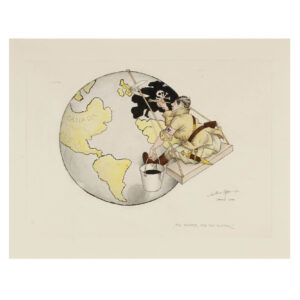
The Painter and the Clipper, Ottawa, 1940
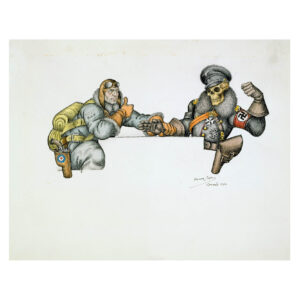
Greeting the Luftwaffe. Ottawa, 1949

Cover illustration, 1944, for his book Ink and Blood (New York: Heritage Press, 1946)
The country was hotly divided on the issue of involvement in World War II. While most of the population was ardently anti-Nazi, Gallup polls from summer 1940 indicated that 80% of those surveyed opposed an American declaration of war against the Axis powers. In fall 1941, Szyk took aim at the leading isolationist figures in the America First Movement, Charles Lindbergh and Senator Gerald Nye. The artist played up Lindbergh’s prior associations with German leaders, like Göring, and portrayed him as a would-be Stormtrooper, just waiting to be appointed Gauleiter of a Nazi America.
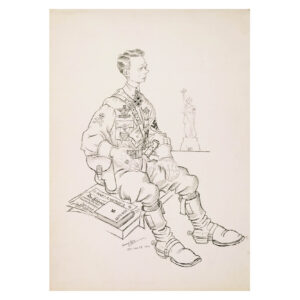
Sein Kampf, caricature of Charles Lindbergh, New York, 1941
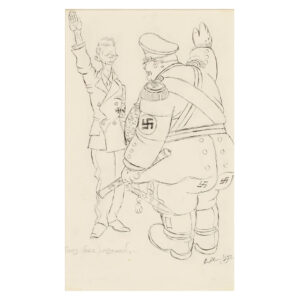
Good Work, Lindchen, caricature of Charles Lindbergh, New York, 1941

Caricature of Senator Gerald P. Nye, New York, 1941
Szyk’s warnings about the threat of Nazism to the United States gained greater public exposure following Putnam’s publication of a collection of his provocative anti-Nazi cartoons and satires in The New Order in summer 1941.

Poland Greets Her Good Neighbors, page removed from The New Order (New York: G. P. Putnam’s Sons, 1941)
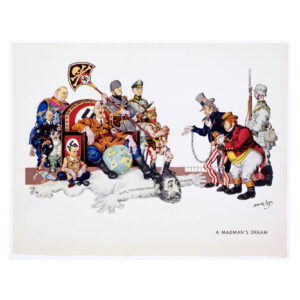
A Madman’s Dream, page removed from The New Order (New York: G. P. Putnam’s Sons, 1941)

Enemies of the Third Reich, page removed from The New Order (New York: G. P. Putnam’s Sons, 1941)
A Madman’s Dream, page removed from The New Order (New York: G. P. Putnam’s Sons, 1941)
Ink on paper, printed, 7.5 x 9.9 in. (19 x 25 cm). United States Holocaust Memorial Museum Collection. Gift of Philip R. House
Action – Not Pity
Szyk was a leading anti-Fascist political caricaturist as well as an advocate for Jewish rescue. He devoted a great deal of time and energy to the Emergency Committee to Save the Jewish People of Europe, and pushed for the establishment of an independent Jewish state in Palestine. Szyk dedicated Tears of Rage to “those of my people who fight for the right to die with their boots on–my pride, my love, my devotion.”
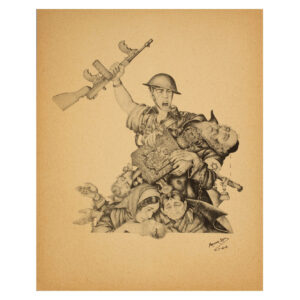
Tears of Rage, fundraising print for the Emergency Committee to Save the Jewish People of Europe, 1944

Modern Moses, fundraising print for the Emergency Committee to Save the Jewish People of Europe, 1944
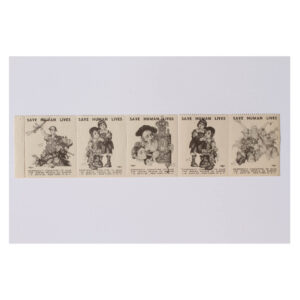
Poster stamps created for the Emergency Committee to Save the Jewish People of Europe; designed 1942, issued 1944-1945
Szyk used his 1942 drawings of Roosevelt’s Four Freedoms to reach a larger, non-Jewish audience and drum up financial support for the Emergency Committee to Save the Jews of Europe. In recycling these images – Freedom of Speech, Freedom of Religion, Freedom from Want, and Freedom from Fear – Szyk intentionally linked Jewish rescue to the foundations of American democracy. Helping to save Jewish lives from destruction at Nazi hands was portrayed as a truly American goal. In 1943, First Lady Eleanor Roosevelt publicly lauded his efforts.
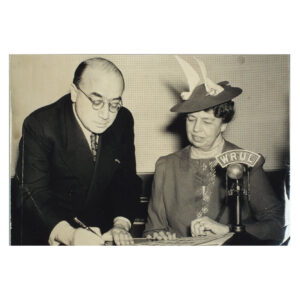
Szyk presents to First Lady Eleanor Roosevelt signed poster stamps created to raise funds for the British-American Ambulance Corps, 1941
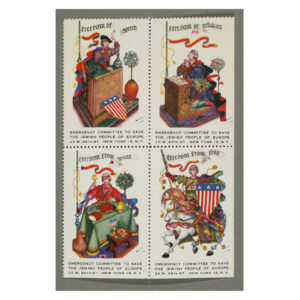
Fundraising poster stamps illustrating President Roosevelt’s Four Freedoms for the Emergency Committee to Save the Jewish People of Europe, c. 1944
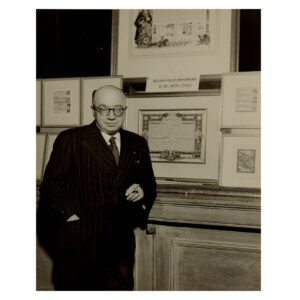
Arthur Szyk at Exhibition in Mt. Vernon, NY, New York c. 1950
Szyk received his US citizenship in 1948. In 1951, he was investigated by the United States House Un-American Activities Committee as a suspected Communist. His son, speaking on his behalf, declared his non-affiliation with any Communist organization. Later that year, on September 13, Szyk suffered a heart attack and died at age 57.
Greeting the Luftwaffe. Ottawa, 1940
Graphite, colored pencil, ink on paper 6.7 x 12.4 in. (17 x 31.6 cm). United States Holocaust Memorial Museum Collection. Gift of Joseph and Alexandra Braciejowski
Cartoon Crusader
During the first four decades of the twentieth century, Polish Jewish artist Arthur Szyk was best known for his richly detailed book illustrations and magnificent illuminations on Jewish themes. He used watercolor and gouache and quill pen and ink on paper and board. He usually began his compositions with a lightly applied but fairly complete “underdrawing” in graphite pencil. The design was then built up with successive layers of transparent and opaque watercolors, painted with sable brushes of varying sizes. A skilled calligrapher, he completed his own lettering in languages as diverse as Polish, Russian, German, French and English – languages he spoke fluently.
When Germany invaded Poland in 1939, Szyk focused his energy and talent on a personal war against Hitler and the Axis. He created caricatures that were as carefully constructed as his illuminations, with exaggerated faces and postures. This crusade against Nazism and German militarism was indelibly linked to his sense of identity as a proud Jew, a Polish patriot, and later as an American.
Watch the Conversations
The Cartoon Crusader Comes to America: Arthur Szyk’s Battle against the Nazis in the New World
Featuring Steven Luckert and Irvin Ungar
November 10, 2021
Additional Resources
Cartoon Crusader
Producer: Universal Pictures
Date: 1946
The Work of Arthur Szyk
Producer: Facing History and Ourselves
Date: 2012
Cartoon Crusader: Arthur Szyk’s War Against Nazism
Producer: The Fritz Ascher Society
Date: 2021
